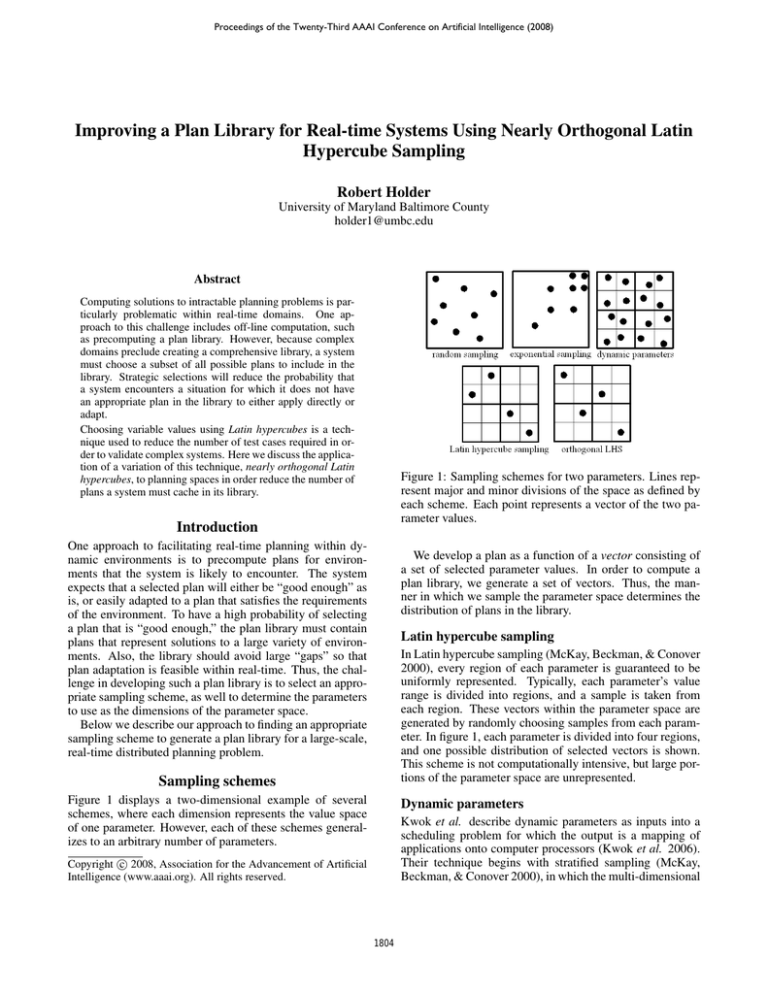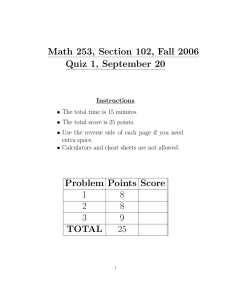
Proceedings of the Twenty-Third AAAI Conference on Artificial Intelligence (2008)
Improving a Plan Library for Real-time Systems Using Nearly Orthogonal Latin
Hypercube Sampling
Robert Holder
University of Maryland Baltimore County
holder1@umbc.edu
Abstract
Computing solutions to intractable planning problems is particularly problematic within real-time domains. One approach to this challenge includes off-line computation, such
as precomputing a plan library. However, because complex
domains preclude creating a comprehensive library, a system
must choose a subset of all possible plans to include in the
library. Strategic selections will reduce the probability that
a system encounters a situation for which it does not have
an appropriate plan in the library to either apply directly or
adapt.
Choosing variable values using Latin hypercubes is a technique used to reduce the number of test cases required in order to validate complex systems. Here we discuss the application of a variation of this technique, nearly orthogonal Latin
hypercubes, to planning spaces in order reduce the number of
plans a system must cache in its library.
Figure 1: Sampling schemes for two parameters. Lines represent major and minor divisions of the space as defined by
each scheme. Each point represents a vector of the two parameter values.
Introduction
One approach to facilitating real-time planning within dynamic environments is to precompute plans for environments that the system is likely to encounter. The system
expects that a selected plan will either be “good enough” as
is, or easily adapted to a plan that satisfies the requirements
of the environment. To have a high probability of selecting
a plan that is “good enough,” the plan library must contain
plans that represent solutions to a large variety of environments. Also, the library should avoid large “gaps” so that
plan adaptation is feasible within real-time. Thus, the challenge in developing such a plan library is to select an appropriate sampling scheme, as well to determine the parameters
to use as the dimensions of the parameter space.
Below we describe our approach to finding an appropriate
sampling scheme to generate a plan library for a large-scale,
real-time distributed planning problem.
We develop a plan as a function of a vector consisting of
a set of selected parameter values. In order to compute a
plan library, we generate a set of vectors. Thus, the manner in which we sample the parameter space determines the
distribution of plans in the library.
Latin hypercube sampling
In Latin hypercube sampling (McKay, Beckman, & Conover
2000), every region of each parameter is guaranteed to be
uniformly represented. Typically, each parameter’s value
range is divided into regions, and a sample is taken from
each region. These vectors within the parameter space are
generated by randomly choosing samples from each parameter. In figure 1, each parameter is divided into four regions,
and one possible distribution of selected vectors is shown.
This scheme is not computationally intensive, but large portions of the parameter space are unrepresented.
Sampling schemes
Figure 1 displays a two-dimensional example of several
schemes, where each dimension represents the value space
of one parameter. However, each of these schemes generalizes to an arbitrary number of parameters.
Dynamic parameters
Kwok et al. describe dynamic parameters as inputs into a
scheduling problem for which the output is a mapping of
applications onto computer processors (Kwok et al. 2006).
Their technique begins with stratified sampling (McKay,
Beckman, & Conover 2000), in which the multi-dimensional
c 2008, Association for the Advancement of Artificial
Copyright Intelligence (www.aaai.org). All rights reserved.
1804
We expect nearly orthogonal LHS sampling will generate
a well-distributed plan library. However, in previous experiments (Holder et al. 2006), we found that plan adaptation
was much more difficult within specific regions of the parameter space. It is likely the optimal scheme will entail
defining and applying nearly orthogonal LHS sampling to
subregions of the parameter space.
parameter space is divided into regions, and several representative vectors are randomly chosen from each region. A
solution is generated for each vector, and then each solution
within a region is evaluated for all the vectors in the region.
Each region is then represented by the best solution generated from the samples within the region.
Exponential sampling
Defining relevant plan parameters
Our previous research (Holder et al. 2006) takes inspiration
from Kwok et al.’s dynamic parameter approach. However,
we only use one region, and, instead of randomly selecting representative vectors, we choose an exponential spacing
distribution of the vectors within the region. Our motivation
is to create a plan library containing a concentration of plans
in regions of the parameters space where plan adaptation is
difficult.
The obvious dimensions of the parameter space include environment variables such sensor location, broadcast station
location, and monitoring appointment time. We may also
consider stochastic measures such as expected sensor failure rate. For example, the system may receive information
that a specific type of sensor has become unreliable. Given
this, a system might construct its plan library to increase
contingencies when generating vectors for high values in the
sensor failure rate dimension. We may also consider adding
planning algorithm parameters as a dimension of our parameter space.
Orthogonal Latin hypercube sampling
Orthogonal Latin hypercube sampling (OLHS) (Ye, Li, &
Sudjianto 1998) builds upon LHS by preventing large gaps
within the parameter space. As in LHS, each parameter is
partitioned into regions and a vector is created by combining samples from each parameter. However, the parameter
space is divided into subregions that must also be sampled
uniformly. Thus, we get a distribution such as that in figure 1 where each region of a parameter is sampled once, and
each quadrant of the region is also only sampled once. Although this technique does offer a uniform distribution with
few samples, it is computationally intensive to apply to parameter spaces with many dimensions.
Conclusion
Our research goal is to increase the efficiency of a largescale, real-time distributed planning problem by developing
a useful precomputed plan library. We expect that nearly
orthogonal LHS sampling will result in an effective tradeoff
between the size of the plan library and the quality of plans
available for situations that our system will encounter. We
have briefly described some sampling schemes and a domain
in which we will apply them.
Nearly orthogonal Latin hypercube sampling
References
Nearly orthogonal Latin hypercube sampling (Cioppa 2002)
attempts to offer many of the benefits of OLHS with less
computational cost. Cioppa shows that as the dimensionality of OLHS increases, the resulting distributions do start to
exhibit gaps in the parameter space, or, as Cioppa describes
it, bad “space-filling.” In order to address both issues, nearly
orthogonal LHS relaxes the orthogonality constraint. This
scheme allows for extensions to higher dimensional parameter spaces, better space-filling, and faster computation.
Cioppa, T. M.
2002.
Efficient Nearly Orthogonal And Space-Filling Experimental Designs For HighDimensional Complex Models. Ph.D. Dissertation, Naval
Postgraduate School.
Dale, M., and desJardins, M. 2007. The FAME problem
domain for distributed planning. In Working Notes of the
AAAI Fall Symposium on Regarding the Intelligence in Distributed Intelligent Systems.
Holder, R.; Pascale, C.; Dale, M.; Daley, R.; Chong, E.;
Shestak, V.; Siegel, H.; and Marinescu, D. 2006. Company Resource Management (CRM) Algorithm Description Document. ARMS Final Report.
Kwok, Y.-K.; Maciejewski, A. A.; Siegel, H. J.; Ahmad,
I.; and Ghafoor, A. 2006. A semi-static approach to mapping dynamic iterative tasks onto heterogeneous computing
systems. Journal of Parallel and Distributed Computing
66:77–98.
McKay, M. D.; Beckman, R. J.; and Conover, W. J. 2000.
A comparison of three methods for selecting values of input variables in the analysis of output from a computer
code. Technometrics 42(1):55–61.
Ye, K. Q.; Li, W.; and Sudjianto, A. 1998. Algorithmic
construction of optimal symetric Latin hypercube designs.
Journal of Statistical Planning and Inference 90(1):145–
159.
Application to large-scale real-time planning
We consider an instance of the FAME domain (Dale & desJardins 2007) consisting of a map with 49 regions, each of
which contains approximately 600 broadcast stations that require monitoring at various times. Within each region there
are 50 mobile sensors that can be deployed to serve monitoring requests. Our system will have to adapt in real-time
to various factors such as incoming monitoring requests and
sensor failures. The system will be evaluated by the percentage of all requests and high-priority requests that it satisfies.
Plan distribution
A good distribution of precompiled plans will enhance the
ability for our sensors to service requests within this dynamic environment. To test this hypothesis, we will populate
a plan library using various sampling schemes.
1805



